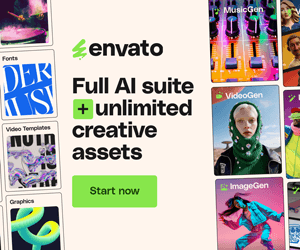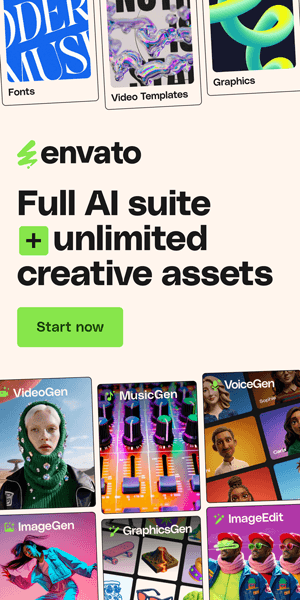AI-Generated Designs: How AI Transforms Graphic Design in 2025
Introduction
Graphic design is entering a new era, and AI-generated designs are leading the charge. In 2025, artificial intelligence is no longer just a futuristic buzzword—it’s a powerful tool that’s reshaping how designers create logos, typography, 3D visuals, and even complete layouts. Whether you’re a professional looking to speed up your workflow or a beginner exploring creative possibilities, AI in graphic design is making the process faster, smarter, and more accessible than ever. Just like the shift we saw in the evolution of typography from print to digital, this transformation is redefining creativity itself.
What Are AI-Generated Designs?
At its core, an AI-generated design is any creative work produced with the help of artificial intelligence tools. Instead of starting every project from scratch, designers can now use AI algorithms to generate logos, layouts, typography, or even 3D visuals with just a few prompts or clicks.
Think of it as having a creative assistant: you provide the idea or direction, and the AI produces design options for you to refine. This can range from a logo concept for a new brand to an intricate pattern for packaging design or even a full web page layout.
There are two main approaches:
AI-assisted design: Where the designer remains in full control, using AI to handle repetitive tasks like background removal, font pairing, or color palette suggestions.
Fully AI-generated design: Where the AI creates an entire piece of artwork or layout with minimal human input—like generating a surreal digital illustration using a tool such as MidJourney.
This technology is gaining momentum across industries, much like how freaky fonts and other creative typography trends pushed designers to experiment with bold, unconventional styles. Now, AI is opening the door to endless possibilities—fast, scalable, and often surprisingly innovative.
Why AI-Generated Designs Matter in 2025
The design world is moving fast, and AI-generated designs are no longer just a novelty—they’re becoming a necessity. In 2025, designers and businesses alike are embracing AI because it solves real-world challenges while opening up exciting creative opportunities. Here’s why it matters:
Faster Workflows and Automation
AI can handle repetitive tasks like resizing images, generating multiple layout variations, or suggesting font pairings in seconds. This frees designers to focus on big-picture creativity instead of tedious details.
Accessibility for Non-Designers
Not everyone has years of design training. AI tools like Canva AI and Adobe Firefly make it possible for entrepreneurs, marketers, and small business owners to create professional-looking graphics without hiring a designer.
Expanding Creative Possibilities
AI isn’t just about speed—it’s about inspiration. By analyzing millions of design references, AI tools can generate unexpected combinations, new styles, and fresh ideas that push creative boundaries. Much like experimenting with luxury fonts in branding, AI helps designers explore looks they might not have considered on their own.
Cost Savings for Businesses
For startups and small companies, hiring a professional design team isn’t always realistic. AI-generated designs make it possible to produce logos, social media graphics, and marketing visuals at a fraction of the cost, leveling the playing field in competitive industries.
Top AI Tools for Graphic Design in 2025
With so many platforms popping up, it can feel overwhelming to choose the right AI tools for your creative projects. To save you time, here are some of the best AI-powered design tools in 2025 that are making waves in the graphic design world:
1. Canva AI
Canva has always been a go-to for quick and easy design, and its AI features make it even more powerful. From instant text-to-image generation to Magic Design (auto layouts), Canva AI helps non-designers and professionals alike whip up social media posts, presentations, and branding assets in minutes.
2. Adobe Firefly
As part of the Adobe Creative Cloud, Firefly is built for serious designers who want AI integrated into their existing workflow. It offers generative fill, style transfers, and AI-powered mockups, making it perfect for refining professional-grade projects without starting from scratch.
3. MidJourney & DALL·E
These two AI art generators are redefining digital illustration. By typing in detailed prompts, you can create hyper-realistic images, surreal artworks, or conceptual visuals for client presentations. Designers use them for mood boards, cover art, and concept exploration.
4. Runway ML & Kaiber
If you’re into motion graphics and video, these tools are worth exploring. They let you generate video clips, animate still images, and create 3D visuals—all powered by AI. Great for designers experimenting with multimedia and marketing campaigns.
5. Fontjoy & Calligrapher.ai
Typography lovers will appreciate these AI-driven font tools. Fontjoy helps pair fonts effortlessly, while Calligrapher.ai creates handwritten styles, making it useful for branding and signature design.
6. Envato Labs
Envato Labs is Envato’s AI-powered creative hub, designed to help designers generate, edit, and enhance visuals with minimal effort. Unlike traditional stock libraries, it offers AI tools like ImageGen, VideoGen, VoiceGen, and creative editing features, allowing designers to produce images, videos, and voiceovers directly from prompts. Many creators use Envato Labs as a one-stop AI solution—automating content generation while still maintaining full control over style, layout, and quality. It’s perfect for designers looking to speed up workflows, experiment with ideas, or produce polished assets faster than ever.
7. Creative Fabrica Studio & Kittl
Both of these design platforms are bringing AI-powered editing and template customization into their ecosystems. With features like AI text-to-image, template suggestions, and instant design variations, they’re ideal for anyone in the print-on-demand or branding space.
These tools cover every corner of AI in design—from branding and typography to 3D motion and ready-made assets. Pairing them strategically (for example, generating visuals in MidJourney and finishing with Envato Elements assets) can save hours while producing professional-quality results.
Applications of AI in Graphic Design
AI isn’t just a trendy tool—it’s becoming part of everyday design workflows. From logos to full website layouts, here are the most exciting applications of AI-generated designs in 2025:
Logo and Branding Design
AI tools like Looka and Canva AI can generate dozens of logo concepts in seconds. Businesses use these as a starting point, while designers refine the details to create unique, memorable brand identities. Pairing AI-generated logos with assets from Envato Elements can take branding projects to the next level.
Pattern and Texture Generation
Need a background pattern, textile print, or packaging texture? AI can create endless variations with just a prompt. Instead of spending hours drawing by hand, designers can now explore fresh, modern looks in minutes.
3D Visuals and Motion Graphics
With platforms like Runway ML and Kaiber, creating 3D models or motion graphics is easier than ever. Imagine producing a product animation or immersive ad campaign without advanced 3D modeling skills—AI makes it possible.
Typography and Layout Automation
Font pairing can be tricky, but tools like Fontjoy use AI to suggest combinations that just work. AI also helps automate layouts, instantly adapting designs to multiple formats (social posts, posters, website headers) while maintaining visual harmony. For inspiration, check out our guide to luxury fonts for branding.
Web, App, and UI/UX Design
Some AI platforms now generate wireframes and UI designs based on user input. This helps startups and designers save time during the prototyping phase while ensuring clean, functional layouts.
In short, AI-generated designs are expanding what’s possible in graphic design. Instead of replacing creativity, they enhance it, giving designers more freedom to experiment, test ideas, and deliver results faster.
Benefits of Using AI-Generated Designs
Adopting AI in graphic design isn’t just about keeping up with trends—it’s about working smarter. Here are the biggest benefits designers and businesses are seeing in 2025:
Saves Time and Boosts Productivity
AI speeds up workflows by automating repetitive tasks like background removal, resizing, or generating layout variations. What used to take hours can now be done in minutes, giving designers more time to focus on the creative aspects of their projects.
Generates Fresh Creative Inspiration
Sometimes every designer hits a creative block. AI tools act like a brainstorming partner, suggesting unique styles, color palettes, or layouts. Much like exploring freaky fonts
for bold experiments, AI can spark fresh ideas you wouldn’t have thought of on your own.
Scales Design Projects with Ease
Need 50 social media graphics in different formats? AI can adapt one design across multiple platforms instantly. This scalability is a game-changer for agencies, startups, and e-commerce brands managing high-volume content.
Enhances Collaboration with Clients
Instead of waiting days for mockups, designers can generate quick previews using AI. Clients see options faster, give feedback sooner, and projects move forward more smoothly. Tools like Adobe Firefly and Envato Elements are especially handy for creating polished client-ready concepts.
The bottom line? AI-generated designs save time, inspire creativity, and improve collaboration—helping both professionals and beginners achieve more with less effort.
Challenges and Concerns
While AI-generated designs offer exciting opportunities, they also come with challenges that every designer should consider. As AI becomes more integrated into the creative process, here are the key concerns in 2025:
Originality and Copyright Issues
One of the biggest debates around AI in design is ownership. If an AI tool creates a logo or illustration, who owns the rights—you, the tool, or the company behind it? This gray area can create legal and ethical challenges, especially for commercial projects.
Ethical Debates: AI vs. Human Creativity
AI can produce visually stunning results, but many argue it lacks the emotional depth and storytelling that only humans can bring. Some designers worry that relying too heavily on AI could dilute creativity, leading to designs that feel generic.
Risks of Over-Reliance on Algorithms
AI is only as good as the prompts and data it’s trained on. Over-dependence can limit originality and make work feel formulaic. A designer’s unique perspective is still essential to create meaningful designs that stand out.
Impact on Design Jobs and Careers
Another concern is the future of design careers. Will AI replace designers? The reality is more nuanced: AI can take over repetitive tasks, but human creativity, strategy, and brand storytelling remain irreplaceable. Instead of eliminating jobs, AI is shifting the designer’s role toward more strategic, creative thinking.
Understanding these challenges helps designers use AI responsibly—balancing automation with originality and ensuring that creativity stays at the heart of every project.
The Future of AI in Graphic Design: 2025 and Beyond
Artificial intelligence is no longer just a shiny new tool in the designer’s toolkit—it’s becoming the backbone of how we create, personalize, and consume design. As we move into 2025 and beyond, the impact of AI on graphic design will expand in exciting (and sometimes unexpected) ways. Here are a few trends to watch:
1. Hyper-Personalization at Scale
Consumers expect designs that feel made just for them, whether it’s a social media ad, a personalized calendar, or packaging with their name on it. AI makes this possible by analyzing user data, preferences, and behavior to generate customized visuals instantly. Imagine designing a marketing campaign where each viewer sees a unique variation of the artwork—AI turns that into reality.
2. AI-Powered Marketplaces
Marketplaces like Creative Market, Envato Elements, and Creative Fabrica are already leveraging AI to recommend fonts, templates, and assets based on user needs. Expect these platforms to evolve into fully AI-curated hubs, where you’ll not only find design resources but also receive tailored suggestions and even AI-generated templates designed around your project brief. This will save designers time while opening up fresh creative opportunities.
3. AR and VR Design Experiences
With the growth of AR (augmented reality) and VR (virtual reality), AI will play a critical role in building immersive design experiences. Think AR product packaging that changes when scanned with a phone, or VR environments where users can interact with 3D branding elements. For designers, this means expanding skill sets beyond flat graphics and embracing spatial, interactive design powered by AI.
4. Collaboration Between Human Creativity and AI
The future isn’t about AI replacing designers—it’s about enhancing creativity. Designers will increasingly use AI as a brainstorming partner, helping with ideation, mood boards, and early drafts, while the final polish and storytelling remain distinctly human.
In short: AI in graphic design is moving from “nice-to-have” to “essential.” Personalization, smarter marketplaces, and immersive AR/VR experiences will define the next era of design—and the designers who embrace these trends will lead the way.
Conclusion: Embracing the AI-Driven Design Era
AI isn’t here to take over graphic design—it’s here to push the boundaries of what’s possible. From speeding up workflows and personalizing experiences to opening doors to AR/VR creativity, the future of design is a blend of human imagination and machine intelligence.
For designers, marketers, and entrepreneurs, this means one thing: opportunity. By adopting AI tools early, exploring AI-powered marketplaces like Envato Elements, Creative Market, and Creative Fabrica, and staying curious about emerging trends, you’ll position yourself ahead of the curve.
At the end of the day, the magic of design still comes from you—the creator. AI just helps amplify your vision, turning your ideas into professional-grade designs faster than ever before.
✨ Ready to step into the future? Start experimenting with AI design tools today, explore curated assets on marketplaces like Envato Elements, and see how technology can transform your creative process.
Frequently Asked Questions About AI-Generated Designs
AI-generated designs are visuals, layouts, and creative assets made with the help of artificial intelligence tools. They use algorithms and machine learning to generate logos, typography, 3D models, illustrations, and even complete layouts with minimal human input.
In 2025, AI-generated designs are used for logo creation, branding, typography, web design, 3D visuals, motion graphics, and even UI/UX layouts. Designers use AI to speed up repetitive tasks and explore new creative possibilities.
Some of the top AI tools for designers include:
Canva AI and Adobe Firefly for quick designs
MidJourney and DALL·E for illustrations
Fontjoy and Calligrapher.ai for typography
Runway ML and Kaiber for motion and 3D design
AI can’t fully replace human designers. While it speeds up design processes and generates ideas, human creativity, storytelling, and emotional connection remain essential. AI is best seen as a collaborator rather than a replacement.
Key challenges include:
Originality and copyright concerns
Risk of over-dependence on algorithms
Ethical debates around AI vs. human creativity
Potential impact on traditional design jobs
The future of AI-generated designs looks promising. Expect more personalized tools, integration with AR/VR experiences, AI-powered design marketplaces, and enhanced collaboration between AI and human designers in the creative process.
Tags
Subscribe
Join the Advise Graphics community and get exclusive design resources, tips, and updates delivered straight to your inbox.
Quick links
Copyright
© 2025 Advise Graphics. All rights reserved.
Cop© 2025 Advise Graphics. All rights reserved.











